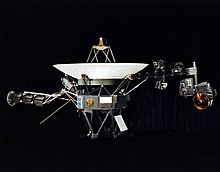Space exploration
Space Exploration (Engl. Spaceexploration , literally "Space Exploration") is the active exploration of space either through observation, remote sensing , probing of celestial bodies or terrestrial (conducted on Earth) experiments let be transferred to states in space.
Space exploration operations performed at the beginning of the 21st century are particular
- the launch of space probes to planets , moons and asteroids ,
- conducting experiments on board space stations (such as the ISS , formerly the Russian Mir ) or
- the observation of objects through radio and space telescopes , for example SOHO or the Hubble space telescope .
Space exploration uses space travel techniques , but some of it also takes place on earth. Conversely, only a small part of space travel is used for space research; a large part of space travel has other purposes (such as commercial or military).
Manned space exploration
Beginning in 1961

When the Soviet Union its first cosmonaut Yuri Gagarin had sent into orbit, began in the Soviet Union and the United States , the manned space research , as a race between the social systems. When the USA landed on the moon , manned space exploration reached its first peak. These include above all the Apollo flights , which led to multiple landings on the moon.
Planning
In the future, space research could also include sending space travelers to distant objects, such as the Earth's moon , Mars or Jupiter's moons, with the inefficiency of the engines making space travel longer operations. At the same time, supply problems are to be expected with regard to fuel , food , air , water and other consumer goods. In addition, for astronauts who are far outside the magnetic field , the cosmic rays move the earth, for example by solar flares dangerous, which has a longer exposure time cancer can increase -Risk. Thus, manned space exploration on distant objects remains unlikely, at least in the 2010s.
New scientific findings from manned space research
The main investigations are the effects of weightlessness on humans , animals and plants .
Unmanned space exploration
Start of the space age in 1957
Sputnik 1 , the first man-made artificial satellite launched in October 1957, marks the beginning of unmanned space exploration. In the course of the following decades, many spacecraft followed,scientifically exploringnear-Earth space, asteroids, the back of the moon and even the surface of Mars .
It is very likely that the majority of space research will continue to be carried out by automatic probes, as they can perform most of the required tasks as well or even better than humans, have no supply problems on their flight, and neither on a return flight are dependent on a comprehensive life support on board. All of this makes them significantly cheaper and gives them drastic advantages in terms of possible uses and duration of use. The only disadvantage compared to manned space exploration is the lack of flexibility of the probes, which can only carry out their predetermined tasks.
By far the longest running unmanned research mission in space are the two probes Voyager 1 and Voyager 2 , launched in 1977 , which are still in operation and have since left the solar system . Newer unmanned missions are Deep Impact or the two Mars rovers Spirit and Opportunity .
Spectacular scientific findings from unmanned space research
The many unexpected results of the space probes should be mentioned here: volcanism on Jupiter's moon Io , the dense atmosphere of Venus , geysers on Neptune's moon Triton , methane lakes on Saturn's moon Titan .
See also
- Asteroid mining
- Committee on the Peaceful Uses of Outer Space
- Space exploration timeline
- List of launcher lists
- List of space probes
- Space Resource Act , Space Age
Web links
- Deutschlandfunk.de , Wissenschaft im Brennpunkt , August 28, 2017, Dirk Lorenzen : Gold rush and castles in the air
